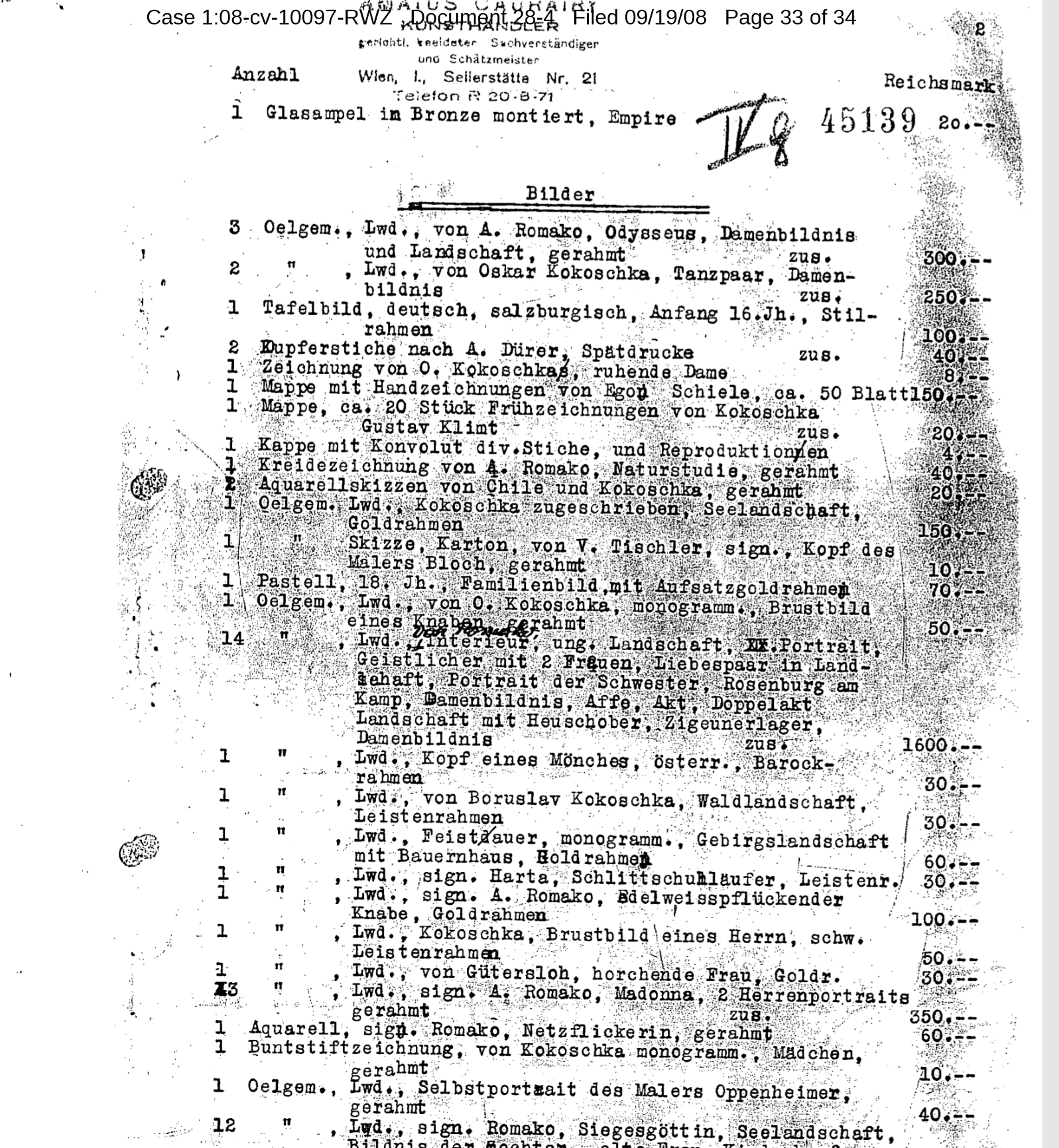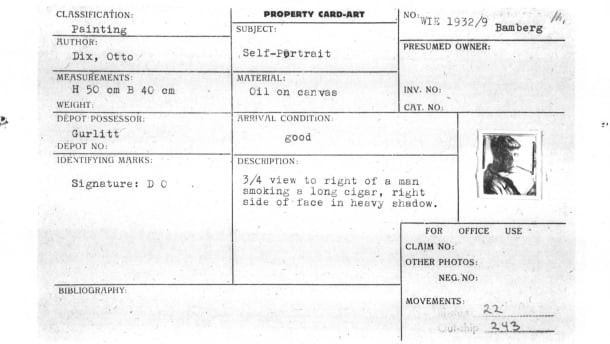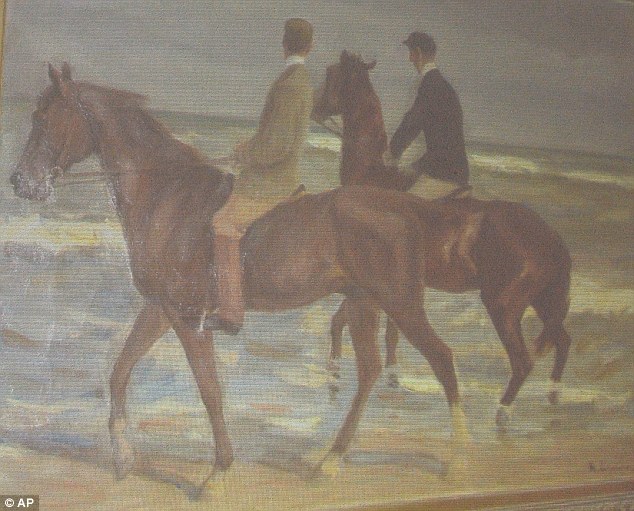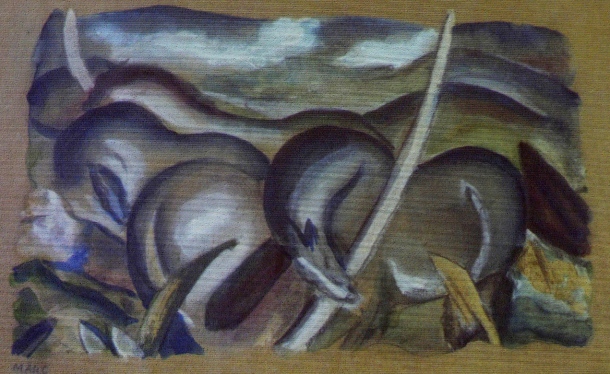There has been some renewed interest in the case a decade or so ago involving a claim by the heir of Oskar Reichel’s family to a painting in the Museum of Fine Arts Boston: Two Nudes (Lovers) by Oskar Kokoschka. In response I’ve decided to post an excerpt from my book A Tragic Fate—Law and Ethics in the Battle Over Nazi-Looted Art (ABA, 2017).
It has been suggested that the MFA somehow concealed its rationale or the documentary evidence on the basis of which it concluded that the painting should not be restituted. That is simply not so, however. The MFA’s now-curator of provenance, Dr. Victoria S. Reed, authored and the MFA filed an exhaustive report of the museum’s research into the case, accompanied by primary source documents. Whether one agrees or disagrees with its conclusions, the report has been publicly available for more than eleven years. It’s no secret that I have been complimentary of the MFA’s provenance research and transparency in the case—and I don’t think anyone would accuse me of being unsympathetic to claimants generally.
The key reasons for the MFA’s conclusions that the painting had not been sold under duress included the fact that Oskar Reichel’s sons pursued restitution claims vigorously (and successfully) for both real and personal property, including paintings. They never identified this painting in their claims to looted property, however. In addition, the MFA found—and filed publicly—correspondence from Oskar’s last surviving son Raimund from 1982 that explained that the MFA painting was among those that Oskar had given to Otto Kallir to sell in the USA:
Exhibit 65 to Dr. Reed’s Report
The MFA drew the conclusion, to which there was no specific evidence to the contrary, that this was in contrast to the property that had been taken from Oskar. This is in the context of the general presumption of invalidity for transactions between 1933 and 1945 involving persecuted groups.
I have been very critical of museums that I believe have not adhered to the spirit of the Association of Art Museum Directors’ guidance on Nazi-looted art claims where I think it is appropriate. But in my opinion—and that’s all it is, my opinion—the MFA is an example of a museum worthy of praise for following those principles of research and transparency (and not only with regard to Nazi-spoliation, but its collection generally).
Please do note that some of the analysis of the applicable statute of limitations has been superseded by the 2016 Holocaust Expropriated Art Recovery Act (HEAR Act), but the case went to a final judgment before that law was passed and was thus not affected by it.
I urge you to consider the case with an open mind and reach your own conclusions. I have done my best to explain my thinking, which you may judge for yourself. The press coverage at the time was very critical (some of which resonated for me until I reviewed the case in detail), which in hindsight is probably attributable in part to the fact that I don’t recall any contemporary coverage that addressed specifically the actual research that the MFA did and made public.
The following is re-published with the permission of the author, and may not be copied, reproduced, or republished in any fashion without express written permission of the author, whom you may contact using the links on this page. A Tragic Fate—Law and Ethics in the Battle Over Nazi-Looted Art © Nicholas M. O'Donnell (2017) is available in hardcover and Kindle editions on Amazon.com. I hope you find it informative and thought provoking.
* * *
Read More
Topics:
Galerie St. Etienne,
Nazi-looted art,
Association of Art Museum Directors,
Claudia Seger-Thomschitz,
Oskar Kokoschka,
Museum of Fine Arts Boston,
Holocaust Expropriated Art Recovery Act,
HEAR Act,
A Tragic Fate,
Two Nudes (Lovers),
Oskar Reichel,
Otto Kallir,
Victoria S. Reed,
Otto Nierenstein
A recent report by the World Jewish Restitution Organization (WJRO) has made strong criticisms of American museums with respect to their handling of Nazi-looted art claims. In particular, the report criticizes the assertion of timeliness defenses such as statutes of limitations. The report focuses in particular on cases involving the Museum of Fine Arts, Boston, the Norton Simon Museum in Pasadena, the Toledo Museum of Art, and the Fred Jones, Jr. Museum at the University of Oklahoma. There is no state control over the vast proportion of art in America the way there is in most European countries, and thus, no possibility of singular, nationalized approaches. In response to the report, some of the museums mentioned have defended their strategies, though in some cases the players are talking past each other. What is undeniable is that whether as a function of the nature of U.S. museums (largely private, rather than public), it is hard to say there is a coordinated approach to the issue, good or bad. The report is lengthy and detailed, and well worth a read in depth that space here does not permit. In some ways, the question it poses boils down to this: is determining the historical truth the obligation of everyone involved or is there some room to prevail without addressing the larger issues?
Read More
Topics:
Toledo Museum of Art,
Street Scene in Tahiti,
Léone Meyer’s,
American Association of Museums,
Two Nudes,
La bérgère,
AAMD Task Force on the Spoliation of Art during th,
Thyssen-Bornemisza Collection,
Rue St. Honoré après-midi êffet de pluie,
University of Oklahoma,
Cassirer,
Nazi-looted art,
Washington Conference on Holocaust Era Assets,
Fred Jones Jr. Museum,
Washington Principles on Nazi-Confiscated Art,
World Jewish Restitution Organization,
WJRO,
Association of Art Museum Directors,
Restitution,
American Alliance of Museums AAM,
World War II,
Paul Gaugin,
Camille Pissarro,
Oskar Kokoschka,
Museums,
Museum of Fine Arts Boston,
AAMD,
Norton Simon Museum in Pasadena
Der Spiegel reports today (link in German) about how German museums are joining the chorus of frustration about the lack of information about the Hildebrand and Cornelius Gurlitt collection find. From this perspective, this development is not a surprise. I was speaking to an international law class last night at Sarah Lawrence College, and one of the students asked me what the reaction in Germany would be. My feeling was that sooner rather than later, the German museum community, and likely the federal government, will push for a forward-looking solution. Present-day Germany takes questions about the Holocaust quite seriously, and for this collection to have turned up in Germany is sparking an embarrassment that could lead to more decisive action. The problem right now seems to be that everyone is waiting for someone else to make the first move.
Read More
Topics:
Jeu de Paume,
unbekannte Meisterwerke,
February 13 1945,
FAZ,
Focus,
Hildebrand Gurlitt,
Dresden firebombing,
Max Fisher,
Cornelius Gurlitt,
S. Lane Faison,
Linz Führermuseum,
Munich Central Collecting Point,
Monopol,
Wiesbaden Collecting Point,
Dresden,
HARP,
Reinhard Nemetz,
Max Liebermann,
WWII,
Monuments Men,
Gurlitt Collection,
Max Beckmann,
Otto Dix,
Degenerate Art: The Fate of the Avant-Garde in Naz,
Auktionshaus Lempertz,
Entartete Kunst,
Fine Arts and Archives Program,
Nazis,
Marc Chagall,
Organisation Todt,
Paul Klee,
Entdeckung verschollener Kunst,
beschlagnahmte Bilder,
Dresdner Bank,
Belvedere,
Fritz Todt,
Holocaust Art Project,
Hamburg Kunstverein,
MFAA,
Roberts Commission,
Angela Merkel,
Restitution,
Wien,
Monuments Fine Arts and Archives,
Selbstporträt,
World War II,
degenerate art,
Erben,
Raubkunst-Bildern,
Portrait of Wally,
Washi,
Löwenbändiger,
Austria,
Franz Marc,
Oskar Kokoschka,
Washington Principles,
Ernst Ludwig Kirchner,
München,
Pablo Picasso,
Dr. Herman Voss,
Museums,
Kristallnacht,
Riders on the Beach,
Hans Posse,
Nazi Raubkunst,
Vienna,
Alfred Weidinger,
Henri Matisse,
Self Portrait,
Emil Nolde
Read More
Topics:
Jeu de Paume,
unbekannte Meisterwerke,
February 13 1945,
FAZ,
Focus,
Hildebrand Gurlitt,
Dresden firebombing,
Max Fisher,
Cornelius Gurlitt,
S. Lane Faison,
Linz Führermuseum,
Munich Central Collecting Point,
Monopol,
Wiesbaden Collecting Point,
Dresden,
HARP,
Reinhard Nemetz,
Max Liebermann,
WWII,
Monuments Men,
Gurlitt Collection,
Max Beckmann,
Degenerate Art: The Fate of the Avant-Garde in Naz,
Auktionshaus Lempertz,
Entartete Kunst,
Fine Arts and Archives Program,
Nazis,
Marc Chagall,
Organisation Todt,
Paul Klee,
Entdeckung verschollener Kunst,
beschlagnahmte Bilder,
Dresdner Bank,
Belvedere,
Fritz Todt,
Holocaust Art Project,
Hamburg Kunstverein,
MFAA,
Roberts Commission,
Angela Merkel,
Restitution,
Wien,
Monuments Fine Arts and Archives,
World War II,
degenerate art,
Erben,
Raubkunst-Bildern,
Portrait of Wally,
Washi,
Löwenbändiger,
Austria,
Franz Marc,
Oskar Kokoschka,
Washington Principles,
Ernst Ludwig Kirchner,
München,
Pablo Picasso,
Dr. Herman Voss,
Kristallnacht,
Riders on the Beach,
Hans Posse,
Nazi Raubkunst,
Vienna,
Alfred Weidinger,
Henri Matisse,
Emil Nolde
Catherine Hickley reports from Berlin that the government of Chancellor Angela Merkel is looking into ways to put lists and/or photographs online concerning the Cornelius Gurlitt seizure of roughly 1,400 paintings with connections to Nazi looting. This followed heavy complaints in the first days of the revelation, that the government had failed to identify what has been found. The biggest question remains why this remained a secret for roughly two years since the discovery. Merkel’s government claimed yesterday it learned of the find only in the last few months.
Read More
Topics:
Stephanie Barron,
Jeu de Paume,
unbekannte Meisterwerke,
Focus,
Hildebrand Gurlitt,
Theo Hermsen,
S. Lane Faison,
Linz Führermuseum,
Munich Central Collecting Point,
Wiesbaden Collecting Point,
HARP,
Max Liebermann,
WWII,
Monuments Men,
Alt Aussee,
Gurlitt Collection,
Max Beckmann,
Association for Research into Crimes Against Art,
Monuments,
Degenerate Art: The Fate of the Avant-Garde in Naz,
Albrecht Dürer,
Auktionshaus Lempertz,
Entartete Kunst,
Fine Arts and Archives Program,
Nazis,
Marc Chagall,
Paul Klee,
Entdeckung verschollener Kunst,
beschlagnahmte Bilder,
Holocaust Art Project,
Judge Arthur Tompkins,
Roberts Commission,
Angela Merkel,
Restitution,
1939 Galerie Fischer auction,
World War II,
degenerate art,
Capt. Doubinsky,
Los Angeles County Musuem of Art,
Erben,
Raubkunst-Bildern,
Altmann v. Republic of Austria,
Portrait of Wally,
Löwenbändiger,
Marc Masurovsky,
Franz Marc,
Oskar Kokoschka,
Ernst Ludwig Kirchner,
München,
Pablo Picasso,
ARCA,
Lawyers' Committee for Cultural Heritage Preservat,
Nazi Raubkunst,
Henri Matisse,
Emil Nolde
The German magazine Focus broke a story over the weekend that could be the biggest restitution news since Portrait of Wally or Altmann v. Republic of Austria: roughly 1,400 paintings were found in a Munich apartment that may have been seized, looted, or sold bought under duress by the Nazis in the 1930s as part of their drive to purge what they called “degenerate”—but extremely lucrative—art (the Focus coverage is extensive and excellent, though fair warning, in German). The paintings, which were apparently recovered not recently, but in 2011 as part of a customs seizure related to a currency declaration of all things, include works by Pablo Picasso, Henri Matisse, Marc Chagall, Emil Nolde, Franz Marc, Max Beckmann, Paul Klee, Oskar Kokoschka, Ernst Ludwig Kirchner, Max Liebermann and Albrecht Dürer, from collections traced back to Paul Rosenberg and others who had to abandon their property during the war, all long thought lost to the destruction of the war. They are valued in excess of 1 billion euros.
Read More
Topics:
Stephanie Barron,
unbekannte Meisterwerke,
Focus,
Hildebrand Gurlitt,
S. Lane Faison,
Linz Führermuseum,
Max Liebermann,
WWII,
Monuments Men,
Alt Aussee,
Gurlitt Collection,
Max Beckmann,
Degenerate Art: The Fate of the Avant-Garde in Naz,
Albrecht Dürer,
Auktionshaus Lempertz,
Entartete Kunst,
Nazis,
Marc Chagall,
Paul Klee,
Entdeckung verschollener Kunst,
beschlagnahmte Bilder,
Restitution,
1939 Galerie Fischer auction,
World War II,
degenerate art,
Los Angeles County Musuem of Art,
Erben,
Raubkunst-Bildern,
Altmann v. Republic of Austria,
Portrait of Wally,
Löwenbändiger,
Franz Marc,
Oskar Kokoschka,
Ernst Ludwig Kirchner,
München,
Pablo Picasso,
Lawyers' Committee for Cultural Heritage Preservat,
Nazi Raubkunst,
Henri Matisse,
Emil Nolde






